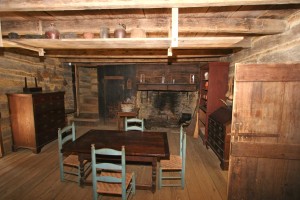Welcome to Alamance Battleground
The Battle of Alamance was fought on Thursday, May 16, 1771. It pitted two groups of North Carolinians against each other. There were approximately 2,000 backcountry farmers called Regulators and around 1,000 militia troops (citizen soldiers) under the command of Royal Governor William Tryon involved in the two-hour battle. Having officers, a battle plan, and more weaponry (which included eight cannon), the royal governor and his men easily defeated the ill-prepared Regulators. Governor Tryon reported that nine of his men were killed and sixty-one wounded in the military engagement. Although undetermined, the Regulator casualties would end up being much greater. It is possible that as many as 100 Regulators may have been killed. The Battle of Alamance officially ended the so-called Regulator movement that began in the 1760’s.
Unfair taxation, dishonest and corrupt government officials, and the lack of representation were all serious concerns of the Regulators. In most cases, government officials (sheriffs, clerks of court, registers of deeds, etc.) attained their positions through appointments by men in power, not by elections involving the citizenry of the colony. The Regulators sought a better regulation of these government officials and more control of their own affairs. Geographical, social, and economic factors all had effects on the Regulator movement.
The geography of the region in backcountry North Carolina limited the westerners’ trading capabilities with their eastern counterparts. Most of the rivers were not navigable and the valleys traveled northeast to southwest, making it much easier to trade in Virginia and South Carolina. The western farmers (Regulators), led a simple but harsh life, depending on farming and bartering to supply their basic needs. Few ever reached a status involving a great degree of wealth or education.

With the coastal area of North Carolina being settled earlier, its residents were better established and wealthier, meaning they enjoyed easier lifestyles and more educational opportunities. Through the seaports, the eastern North Carolinians were involved in direct trade with England. It is also known that they basically attempted to copy the aristocratic style of British life.
So, with the colony divided into two generally different societies, an eastern seat of government appointing or controlling local officials, and there being confusing tax laws in place, it is easy to understand the feeling of alienation the backcountry people experienced. Initially, the western people sought peaceful means to bring attention to their grievances; these means would include such things as speeches, correspondence, “advertizements,” and petitions. They formed an organization of concerned citizens called the “Association” and eventually became known as the Regulators. For the most
part, the Regulators looked toward Herman Husband as their leader. Men like James Hunter, Rednap Howell, William Butler, and others played major roles, as well.
Due to the lack of corrective action taken by Governor Tryon and the Assembly, frustration and impatience grew among the population of the backcountry. This inaction brought about a turn to more direct and violent action, which led to two riots in the Orange County seat of Hillsborough. The first riot took place in the spring of 1768 when the county sheriff seized a Regulator’s horse and saddle for payment of taxes. Incensed, the Regulators entered the town, captured the sheriff, and retrieved the horse and tack. The second incident came during the fall session of superior court in 1770. More violent, it involved the disruptions of courtroom proceedings, the staging of mock trials, the physical beatings of government officials (like Judge Richard Henderson and Colonel Edmund Fanning), and the basic destruction of Edmund Fanning’s home and personal property.

Mr. Fanning, the register of deeds for Orange County and a militia officer, was no doubt one of the most corrupt officials in the colony. He would eventually be found guilty of extortion in court action initiated by Governor Tryon. When Tryon left to be royal governor of New York (July, 1771), Fanning followed as his personal secretary.
Faced with these violent incidents while trying to reconcile Regulator grievances through legislative action, both Tryon and the Assembly felt they had no choice but to raise and march the militia into the western counties to restore law and order. It all came to an end at the eventual battle fought near the Great Alamance Creek.
Governor Tryon and the militia took fifteen Regulators as prisoners during the
two-hour battle. Out of this total number, seven would be executed by hanging. Tryon ordered that James Few be hanged at the militia campsite without holding a trial. The remaining six men were hanged in Hillsborough on June 19, 1771 following trials. Four of these six men to hang were Robert Matear, James Pugh, Benjamin Merrill, and Captain Robert Messer.
Although the Battle of Alamance was not the first official battle of the American Revolution, it did provide some valuable insight for revolutionaries as discontent with British rule continued to increase. For the approximately 6,000 Regulators who took the oath of allegiance to the Crown, many of them remained loyal to England during the War for Independence. Some of the militia serving under Governor Tryon, who gained valuable military experience at the battle, would end up fighting against the British. Richard Caswell, the first man to serve as governor of the state of North Carolina, was one of those to serve in the militia and later become an integral part of this country’s independence movement.